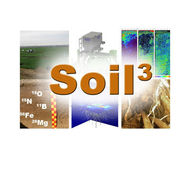Spatial molecular heterogeneity of<scp>POM</scp>during decomposition at different soil depths resolved by<scp>VNIR</scp>hyperspectral imaging (2022.0)
Guigue J., Just C., Luo S., Fogt M., Schloter M., Kögel‐Knabner I., Hobley E.
European Journal of Soil Science, 73 (1),
Abstract
Soil organic matter (SOM) is composed of fractions with different functions and reactivity. Among these, particulate organic matter (POM) is the main educt of new inputs of organic matter in soils and its chemical fate corresponds to the first stages of the SOM decomposition cascade ultimately leading to the association of organic and mineral phases. We aimed at investigating the molecular changes of POM during decomposition at a sub-millimetre scale by combining direct measurements of POM elemental and molecular composition with laboratory imaging visible–near-infrared (VNIR) spectroscopy. For this, we set up an incubation experiment to compare the molecular composition of straw and composted green manure, materials greatly differing in their C/N ratio, during their decomposition in reconstituted topsoil or subsoil of a Luvisol, and recorded hyperspectral images at high spatial and spectral resolutions of complete soil cores at the start and end of the incubation. Hyperspectral imaging was successfully combined with machine learning ensembles to produce a precise mapping of POM alkyl/O-N alkyl ratio and C/N, revealing the spatial heterogeneity in the composition of both straw and green manure. We found that both types of organic amendment were more degraded in the reconstituted topsoil than in subsoil after the incubation. We also measured consistent trends in molecular changes undergone by straw, with the alkyl/O-N alkyl ratio slightly increasing from 0.06 to 0.07, and C/N dropping by about 40 units. The green manure material was very heterogeneous, with no clear molecular changes detected as a result of incubation. The imaging VNIR spectroscopy approach presented here enables high-resolution mapping of the spatial distribution of the molecular characteristics of organic particles in soil cores, and offers opportunities to disentangle the roles of POM chemistry and morphology during the first steps of the decomposition cascade of organic matter in soils.
